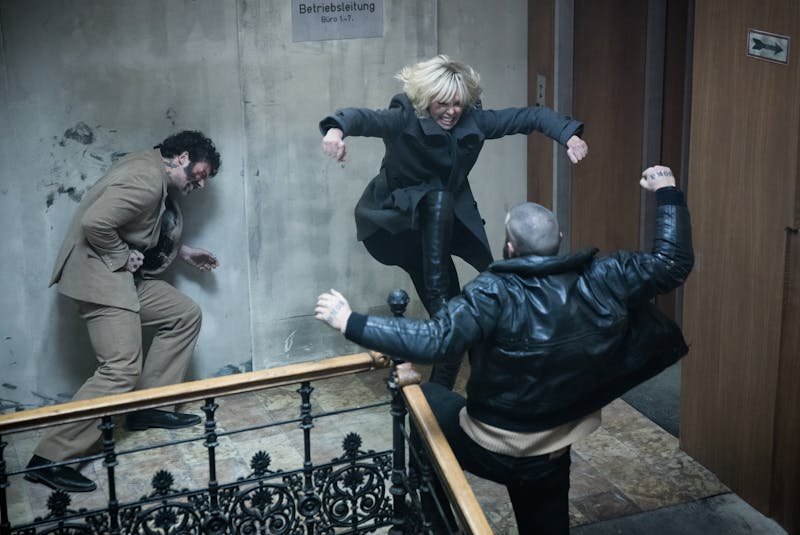There’s an old line by Raymond Chandler: “It was a blonde. A blonde to make a bishop kick a hole in a stained-glass window.” Only here, the blonde is doing the kicking. Lorraine Broughton is punching a man and not gently. Back and forth her arm winds, bouncing the poor chap against the shiny municipal paint on the wall. They’re in a stairwell. She pummels Soviet after Soviet (for that’s what she calls them). They’re luckier than the chap who gets the corkscrew to the eye later, though a little less lucky that the men she slaughtered earlier to the jaunty accompaniment of George Michael’s “Father Figure.” By the end of David Leitch’s new spy thriller Atomic Blonde, our icy heroine has a body count higher than her chain-encrusted high-heeled boots.
It’s November 1989, and Broughton (Charlize Theron) is in Berlin. The British agent is in town to meet up with station chief David Percival (James MacAvoy—Mr. Tumnus from The Lion, The Witch, and the Wardrobe and about as menacing here). Percival is a dissolute loon who gets about 50 percent too much screen time, and he’s more a help than a hindrance in Broughton’s mission to recover a secret list of informers embedded within East Germany. Someone on that list is a highly placed double agent, but who? That’s about it for the plot of Atomic Blonde, which nonetheless plays out in incredible style.
The spycraft element of the movie is a bit ropey. The characters refer to each other’s codenames out loud, often while doing things like staring over the top of the Berlin Wall up some kind of ladder. So much for subterfuge. There are none of the delicious procedural tricks we know and love from le Carré novels or movies like Three Days of the Condor. There are no fiddly radios; no waiting for the moonless night, no treffs.
Some effort has been made with historical detail. Lovers of GDR history will delight to the male character named “Merkel.” Ratty old Trabants abound in the East section of Berlin. But here we break down. The German youth like breakdancing and—oh blessed freedom!—skateboarding. If you look very closely, you’ll glimpse the poster for The Black Crowes’ Amorica on Percival’s wall, even though that album only came out in 1994. Atomic Blonde stylizes the idea of 1989 Berlin, rather than historicizing it. Broughton slices up some audio tape with a razor and somehow it looks like something from pornography.

Instead of history, we have Charlize Theron and we have the music of the end of the ‘80s. The movie opens: Theron’s bruised back, a bath full of ice, a glass full of vodka, a neon blue glow, “Blue Monday.” Theron’s costuming throughout is superb. Although the BOY London tee is a little on the nose, the rest of her outfits irradiate late-‘80s sex.
One evening, Broughton visits a swanky cocktail bar to explore its KGB wildlife. It is here that she meets Delphine (Sofia Boutella), a doe-eyed French agent who plays Broughton’s love interest. Lorraine Broughton walks through the front door, drops her coat into the doorman’s hand, and cruises through the room like a ravenous, blank-eyed shark. Her outfit and hair—here much smoother than in other scenes—is almost exactly the same as Michelle Pfeiffer’s black-sequin look in Scarface, in that scene where she freaks out at the dinner table.
Like Pfeiffer’s Elvira Hancock, Broughton uses her bangs like a shield and her unsmiling mouth like a razor blade. It’s a perfect bit of costuming reference, made complete by Broughton’s ubiquitous cigarette.

The marketing for Atomic Blonde has leaned heavily on the story that Theron does her own stunts, going so far as to include her training footage in the theatrical trailers. Hopefully, the effect of this marketing will be to deify Theron as an action hero, Stallone-style. In this she has few true forebears in American cinema. This character isn’t as emotional as Ripley or The Bride, or as camp as Catwoman or Lara Croft.
She mostly reminded me of Milla Jovovich in the Resident Evil series. Like Jovovich, Theron is muscular, highly-styled, and almost never smiles. The first smile of the movie was, by my count, for Delphine. That affair is classic spy-movie material. There always has to be a vulnerable lover to give our hero a human side—and a weakness.
The movie doesn’t dwell on Broughton’s sexuality, though we do see her shed tears. The Theron/Boutella partnering is totally compelling, and their erotic chemistry might be the atomic element for which the movie is named. There isn’t a great deal of sex that doesn’t happen in the movie trailer, unfortunately. There should have been more sex.
Though Broughton isn’t very Bride-like, Atomic Blonde shares certain structural elements with the Kill Bill series. Specifically, it relies heavily on its soundtrack to add depth and complexity to the fight scenes. And just as Tarantino always over-eggs it, so Atomic Blonde is just a little bit over-egged. Why, when Broughton walks into a East German subversives’ office, is the Tetris music playing so very loudly?
But then, some tunes are just perfect. Broughton does her first cross-town walk to David Bowie’s “Cat People (Putting Out Fire).” Bowie screeches the word “GASOLIIINE” as if it’s Broughton’s middle name. Atomic Blonde is the proverbial stained-glass window, only made of very bright and unsubtle neon. Unhindered by other pretensions, however, it marks a brilliant new phase in Theron’s career.
